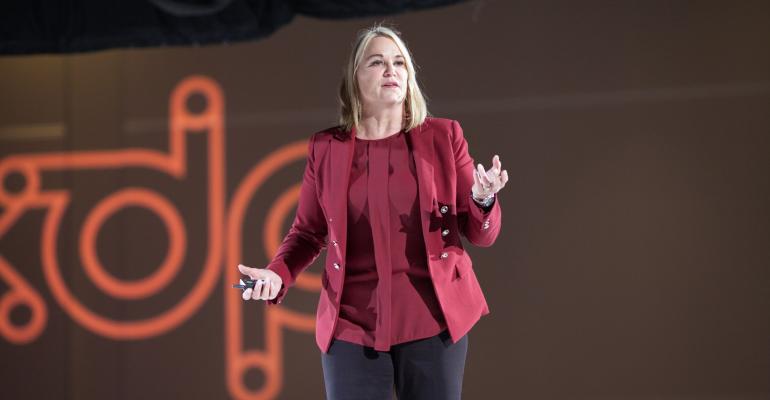Did you know that many men hate to iron so much that they'd rather throw out a wrinkled shirt and buy a new one than pull out the ironing board in their hotel closet? That could just be a fun fact, but in the hands of speaker Kelly McDonald, founder of McDonald Marketing and a top expert in consumer trends, generational differences, and customer experiences, it’s a teachable one.
During a presentation at the American Society of Association Executive’s 2017 Xperience Design Project, McDonald outlined five ways to keep customers—your meeting attendees—rushing back for more. Here’s a bit of her advice, along with takeaways for how we can apply this advice to meetings.
1. Know what makes them tick. Omni Hotels not only took notice of the men-hate-ironing thing, it took it to heart. There's now a select-guest program that offers free ironing of two items.
As the Omni example demonstrates, you need to go more deeply into people's psyches—or at least their behaviors—to come up with things that will be irresistable to them, McDonald said. Another example she offered was Safelite AutoGlass, which sends windshield-repair people to fix your glass right in your driveway. The only problem was that women customers weren’t comfortable with strangers showing up at their homes. So now the company sends a photo of the repair person to its female customers ahead of time so they know who to expect to stop in front of their house.
Takeaways: Observe your attendees closely and crunch the metrics data to find trends. And don’t just think about the usual topics, speakers, and was the food good and the temperature right. Instead, consider things like: When are ladies-room lines longest? What areas of the trade show floor do they seem to avoid? And most importantly, why do attendees do the things they do? Look at not just the behaviors, but the emotions behind the behaviors—something that 360 Live Media’s Don Neal in another session called psychographics.
Once you know what makes your attendees tick and why, then you can come up with fixes that work with their natural ways of thinking and feeling.
2. Create an empathetic atmosphere. McDonald stressed that you should always hire the person, not the resume. Tasks can be taught and skills learned, but empathy is either there or it is not. And don’t be afraid to look outside the usual “pond” of prospects. As she said: “Awesome people are awesome everywhere” and can surely be trained on the other things.
Takeaways: Empathy can be hard to come by when you’re pressed and stressed while the 100th person asks you what the meeting-app password is—and yet how you answer the question can make a huge difference in that attendee's mood and experience going forward. And that's important because, in crowds, emotions are contagious. Staffers who display empathy and kindness will spark a kinder, more friendly meeting. Who doesn't want that?
3. Find out what people want and give it to them. When things go wrong—as they inevitably will—your response will make all the difference in how they feel moving forward. Let’s take a lesson from the contractor who did Kelly McDonald’s kitchen renovation. Whenever an issue cropped up, regardless of whether it was caused by his direct reports or not, his response was, “I’ll take care of it.”
Takeaways: Hold the blame and recriminations and excuses—people don’t really care why there’s shrimp on their plate when they had indicated their shellfish allergy, or why the mic is shreiking feedback, or why they had to wait in line for 20 minutes to get their badge. All they want to know is that you’re on the case. Period.
4. Customize. “Mass is out, customization is in,” said McDonald. My take on this part of her talk was that this is a continuation of the process started when you find out what makes your attendees tick. Again using gender as an example, she said that there are distinct differences between men and women when it comes to making choices. Women tend to prefer lots of options, whereas many men want their options limited to three, she said, and smart marketers and planners will adjust their approaches accordingly. For example, look at home electronics, which are mostly purchased by men: They are usually marketed in groups of three, she said.
Takeaways: Use this intelligence as you create marketing materials—segment your list as you usually would based on data about what each person has attended or shown interest in the past, or their experience level, or however it is you’re dividing your list for customized marketing. Then segment it further by gender to offer three suggestions that men might want to check out, and a few more things for women to peruse.
McDonald also said to take advantage of trends to find new ways to customize. For example, social sharing is trending now. One company that took advantage of that is Coca-Cola, which launched a campaign of soda cans personalized with people’s names on them. And if you can’t find one with your name, no problem; just let the company know and they’ll make one for you—they’ll even design one with your name in Braille. They are making it all about that person. How can planners do that too?
5. Help people, don’t sell them. This is the sum total of her first four points. It all leads up to being a resource—not a seller of services but a trusted advisor.
Takeaways: Don’t come at your marketing from the angle of, “Look at all the great speakers we are offering! And our networking events will be so awesome!” Instead, what’s in it for that person? What problems will she or he find solutions to? Provide content that will help people in their present jobs, their overall careers, and their lives. Thinking of your attendees that way will improve your approach towards them in every area.





